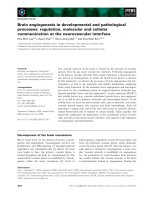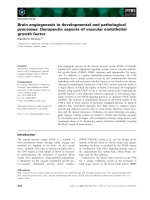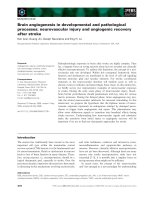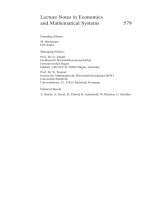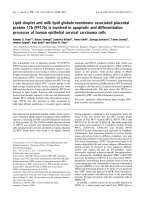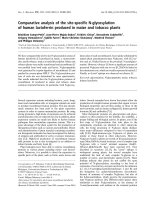Dynamics in Human and Primate Societies: Agent-Based Modeling of Social and Spatial Processes pdf
Bạn đang xem bản rút gọn của tài liệu. Xem và tải ngay bản đầy đủ của tài liệu tại đây (25.79 MB, 413 trang )
Dynamics
in
Human
and
Primate Societies:
Agent-Based Modeling
of
Social
and
Spatial
Processes
This page intentionally left blank
DYNAMICS
IN
HUMAN
AND
PRIMATE
SOCIETIES
Agent-Based
Modeling
of
Social
and
Spatial
Processes
Editors
Timothy
A.
Kohler
George
J.
Gumerman
Santa
Fe
Institute
Studies
in the
Sciences
of
Complexity
New
York Oxford
Oxford University
Press
2000
Oxford
University
Press
Oxford
New
York
Athens Auckland Bangkok Bogota Buenos Aires Calcutta
Cape Town Chennai
Dar es
Salaam Delhi Florence Hong Kong Istanbul
Karachi
Kuala
Lumpur Madrid Melbourne Mexico City Mumbai
Nairobi Paris
Sao
Paulo
Singapore
Taipei Tokyo Toronto Warsaw
and
associated companies
in
Berlin Ibadan
Copyright
©
2000
by
Oxford University Press, Inc.
Published
by
Oxford University
Press,
Inc.
198
Madison Avenue,
New
York,
New
York 10016
Oxford
is a
registered trademark
of
Oxford
University
Press
All
rights reserved.
No
part
of
this publication
may be
reproduced,
stored
in a
retrieval system,
or
transmitted,
in any
form
or by any
means,
electronic,
mechanical, photocopying, recording,
or
otherwise,
without
the
prior permission
of
Oxford University
Press.
Library
of
Congress Cataloging-in-Publication Data
Dynamics
in
human
and
primate societies
:
agent-based modeling
of
social
and
spatial
processes
/
[edited]
by
Timothy
A.
Kohler
and
George
J.
Gumerman.
p. cm. —
(Santa
Fe
Institute studies
in the
sciences
of
complexity)
Includes bibliographical references
and
index.
ISBN
0-19-513167-3
(cloth); ISBN
0-19-513168-1
(pbk.)
Social evolution—Mathematical models.
2.
Social evolution—Computer simulation
3.
Social
history—To 500—Mathematical models.
4.
Social history—To 500—
Computer simulation.
5.
Animal societies—Mathematical models.
6.
Animal societies—Computer simulation.
7.
Social behavior
in
animals—
Mathematical
models.
8.
Social behavior
in
animals—Computer simulation.
I.
Kohler, Timothy
A. II.
Gumerman, George
J.
III.
Series:
Santa
Fe
Institute
studies
in the
sciences
of
complexity (Oxford University Press)
GN360.D89
2000
303.4'01'13—dc21
99-33379
35798642
Printed
in the
United States
of
America
on
acid-free paper
1.
About
the
Santa
Fe
Institute
The
Santa
Fe
Institute (SFI)
is a
private, independent, multidisciplinary
research
and
education center,
founded
in
1984. Since
its
founding,
SFI has
devoted itself
to
creating
a new
kind
of
scientific
research community,
pursuing
emerging science. Operating
as a
small, visiting institution,
SFI
seeks
to
catalyze
new
collaborative, multidisciplinary projects
that
break
down
the
barriers between
the
traditional disciplines,
to
spread
its
ideas
and
methodologies
to
other individuals,
and to
encourage
the
practical
applications
of its
results.
All
titles
from
the
Santa
Fe
Institute Studies
in the
Sciences
of
Complexity
series
will
carry this imprint
which
is
based
on a
Mimbres
pottery design (circa A.D.
950-1150),
drawn
by
Betsy Jones.
The
design
was
selected because
the
radiating feathers
are
evocative
of
the
out-reach
of the
Santa
Fe
Institute
Program
to
many disciplines
and
institutions.
Santa
Fe
Institute Editorial Board
September 1999
Ronda
K.
Butler-Villa,
Chair
Director
of
Publications, Facilities,
&
Personnel, Santa
Fe
Institute
Dr.
David
K.
Campbell
Chair,
Department
of
Physics,
University
of
Illinois
Prof. Marcus
W.
Feldman
Director,
Institute
for
Population
&
Resource Studies,
Stanford
University
Prof. Murray Gell-Mann
Division
of
Physics
&
Astronomy,
California
Institute
of
Technology
Dr.
Ellen Goldberg
President,
Santa
Fe
Institute
Prof. George
J.
Gumerman
Arizona
State
Museum,
University
of
Arizona
Dr.
Erica
Jen
Vice
President
for
Academic
Affairs,
Santa
Fe
Institute
Dr.
Stuart
A.
Kauffman
BIOS
Group
LP
Prof. David Lane
Dipart.
di
Economia Politica,
Modena
University,
Italy
Prof. Simon Levin
Department
of
Ecology
&
Evolutionary
Biology,
Princeton
University
Dr.
Melanie
Mitchell
Research
Professor,
Santa
Fe
Institute
Prof. David
Pines
Department
of
Physics,
University
of
Illinois
Dr.
Charles
F.
Stevens
Molecular
Neurobiology,
The
Salk
Institute
Contributors
List
Robert
L.
Axtell,
Economic Studies,
The
Brookings
Institution,
1775
Massachusetts
Avenue,
NW,
Washington,
DC
20036
and the
Santa
Fe
Institute
Irenaeus
J. A. te
Boekhorst,
University
of
Zurich, Department
of
Computer
Science, Winterthurerstrasse 190, CH-8057 Zurich; e-mail:
Eric
Carr,
Economic Systems
and
Operations Research, Department
of
Engineering,
Stanford
University, Palo
Alto,
CA
94305
Jeffrey
S.
Dean,
Laboratory
of
Tree-Ring Research, P.O.
Box
210058, University
of
Arizona,
Tucson,
AZ
85721-0058
Jim
Doran,
Department
of
Computer Science, University
of
Essex, Wivenhoe
Park, Colchester,
CO4 3SQ
United
Kingdom; e-mail:
Joshua
M.
Epstein,
Economic Studies,
The
Brookings
Institution,
1775
Massachusetts
Avenue,
NW,
Washington,
DC
20036
and the
Santa
Fe
Institute
Nigel
Gilbert,
Department
of
Sociology, University
of
Surrey,
Guildford,
GU2
5XH,
United
Kingdom
George
J.
Gumerman,
University
of
Arizona, Arizona State Museum, Building
#26, Tucson,
AZ
85721-0026
Charlotte
K.
Hemelrijk,
University
of
Zurich, Department
of
Computer
Science, Winterthurerstrasse 190, CH-8057 Zurich; e-mail:
Timothy
Kohler,
Washington State University, Department
of
Anthropology,
College
Hall, P.O.
Box
644910,
Pullman,
WA
99164~4910
and the
Santa
Fe
Institute; e-mail:
James
Kresl,
Washington State University, Department
of
Anthropology,
College
Hall,
P.O.
Box
644910, Pullman,
WA
99164~4910
Mark
Winter
Lake, Institute
of
Archaeology, University
College
London, 31-34
Gordon
Square, London, WC1H
OPY
J.
Stephen
Lansing,
University
of
Arizona,
P.O.
Box
210030, Tucson,
AZ
85721
Mark
Lehner,
16
Hudson Street, Milton,
MA
02186
Stephen
McCarroll,
University
of
California
at San
Francisco, 1350 Seventh
Avenue,
San
Francisco,
CA
94143
Miles
T.
Parker,
The
Brookings
Institution,
1775 Massachusetts Avenue
NW,
Washington,
DC
20036
John
W.
Pepper,
University
of
Michigan, Museum
of
Zoology,
Ann
Arbor,
MI
48109-1079
Robert
G.
Reynolds,
Wayne State University, Department
of
Computer
Science, 5143 Cass
Avenue,
Detroit,
MI
48202
Brian
Skyrms,
University
of
California,
Department
of
Philosophy, Irvine,
CA
92697
Cathy
A.
Small,
Northern Arizona University, Department
of
Anthropology,
Box
15200,
Flagstaff,
AZ
86011
Barbara
Smuts,
University
of
Michigan, Museum
of
Zoology,
Ann
Arbor,
MI
48109-1079
Alan
C.
Swedlund,
University
of
Massachusetts
at
Amherst,
Department
of
Anthropology,
MA
01003
Carla
Van
West,
Statistical Research Inc., 2500
N.
Pantano,
Suite
218, Tucson,
AZ
31865
Richard
H.
Wilshusen,
University
of
Colorado, Department
of
Anthropology,
Boulder,
CO
80309
Henry
T.
Wright,
Museum
of
Anthropology,
Ann
Arbor,
MI
48109-1079; e-mail:
hwright@umich.
edu
Contents
Preface
xi
Putting Social Sciences Together Again:
An
Introduction
to the
Volume
Timothy
A.
Kohler
1
Nonlinear
and
Synthetic Models
for
Primate Societies
Irenaeus
J. A. te
Boekhorst
and
Charlotte
K.
Hemelrijk
19
The
Evolution
of
Cooperation
in an
Ecological Context:
An
Agent-
Based Model
John
W.
Pepper
and
Barbara
B.
Smuts
45
Evolution
of
Inference
Brian
Skyrms
77
Trajectories
to
Complexity
in
Artificial Societies: Rationality, Belief,
and
Emotions
Jim E.
Doran
89
MAGICAL
Computer Simulation
of
Mesolithic Foraging
Mark
Winter Lake
107
Be
There Then:
A
Modeling Approach
to
Settlement Determinants
and
Spatial
Efficiency
Among Late Ancestral Pueblo Populations
of
the
Mesa Verde Region, U.S. Southwest
Timothy
A.
Kohler, James Kresl,
Qarla
Van
West, Eric
Carr,
and
Richard
H.
Wilshusen
145
Understanding Anasazi Culture Change Through Agent-Based
Modeling
Jeffrey
S.
Dean,
George
J.
Gumerman, Joshua
M.
Epstein,
Robert
L.
Axtell, Alan
C.
Swedlund, Miles
T.
Parker,
and
Steven McCarroll
179
Dynamics
in
Human
and
Primate Societies, edited
by T.
Kohler
and
G.
Gumerman, Oxford University Press, 1999.
ix
i
i
Contents
Anti-Chaos, Common Property,
and the
Emergence
of
Cooperation
J,
Stephen Lansing
207
The
Political
Impact
of
Marriage
in a
Virtual Polynesian Society
Cathy
A.
Small
225
The
Impact
of
Raiding
on
Settlement
Patterns
in the
Northern Valley
of
Oaxaca:
An
Approach Using Decision Trees
Robert
G.
Reynolds
251
The
Fractal House
of
Pharaoh: Ancient Egypt
as a
Complex Adap-
tive System,
a
Trial Formulation
Mark
Lehner
275
Modeling
Sociality:
The
View
from
Europe
Nigel
Gilbert
355
Agent-Based Modeling
of
Small-Scale Societies:
State
of the Art and
Future Prospects
Henry
T.
Wright
373
Index
387
X
Preface
The
Santa
Fe
Institute (SFI)
is
interested
in
understanding evolving com-
plex social, biological,
and
physical adaptive systems
in a
most general sense
(see
Cowan
et al.
1994). Those
of us at SFI
interested
in the
evolution
of
social behavior have tended
to
focus
on
either small-scale societies
or on
spe-
cific
aspects
of
more complex societies, such
as the
economy.
The
conference
providing
the
genesis
for
this volume itself evolved
from
four
previous
efforts
to
understand
and
document
the
evolution
of
social
and
political complexity
of
the
small-scale agricultural groups
of the
American Southwest.
The first of
these
was a
workshop sponsored
by the
School
of
American
Research, Santa
Fe,
held
in
1983.
The
resulting volume (Cordell
and
Gumer-
man
1989) provided
an
overview
of the
Southwest
by
subareas. This volume
emphasized periods
of
relative
stasis
that
were punctuated
by
periods
of
rapid
and
similar changes area wide,
which
we
called "hinge points."
The
second
and
third were sponsored jointly
by the
School
and SFI and
were
a
direct
outgrowth
of
Murray Gell-Mann's interest
in the
prehistoric Southwest
and
his
view
that
SFFs concepts
and
tools might
be
profitably used
to
under-
stand evolving social complexity
in the
region.
The
second workshop, titled
"The Organization
and
Evolution
of
Prehistoric Southwestern Society,"
em-
phasized evolutionary processes
that
crosscut locales
and
characterized
the re-
gion (Gumerman 1994). Topics included environment
and
demography, land-
Dynamics
in
Human
and
Primate
Societies,
edited
by T.
Kohler
and
G.
Gumerman,
Oxford
University
Press, 1999.
XI
xiii
XII
Preface
use
patterns, aggregation
and
abandonment, health
and
disease,
and
social
and
economic interaction.
The
third workshop
followed
a
more typical
SFI
format
(Gumerman
and
Gell-Mann 1994).
The
participants
included
not
only
archaeologists
and
ethnologists,
but
demographers, evolutionary biologists,
computer
modelers,
and
complexity theorists. Working groups
focused,
not
only
on the
role
of
complexity theory
and the
prehistory
of the
Southwest,
but
also
on the
nature
of
archaeological explanation.
The
fourth
workshop,
held
in
1992, proceeded logically
from
the
others,
focusing
on
"the
way in
which
prehistoric Southwesterners made decisions
and
took
steps
to
solve
some
of
their everyday problems,
and
changed thereby
the
complexity
of
their economies, technologies, societies,
and
religious institutions" (Tainter
and
Tainter 1996:3).
The use of
complexity theory
has
provided archaeologists with
an ex-
panded theoretical
framework
for
understanding
the
past.
Theoretical stances,
such
as
classic systems theory,
in
some ways
the
precursor
of
complexity
re-
search
(Miller
1965,
Bertalanffy
1986), have provided productive
ways
of
con-
ceptualizing
the
evolutionary trajectory
of
preliterate societies,
for
example,
by
leading
us to
identify
negative
or
positive
feedback
loops through
which
change
is
resisted
or
amplified.
Some
of us at SFI
felt,
however,
that
there
are
aspects
of the
study
of
culture change
as it is
typically practiced
that
need
to be
modified.
Narrative
uses
of
theory, including concepts
from
complex
adaptive
system theory, have
helped anthropologists understand
how
culture changes.
But
while
such uses
of
these theories have helped
in
conceptualizing culture change
in
specific
his-
torical situations, they have
not
provided rigorous
scientific
explanations
for
cross-cultural processes
of
cultural evolution.
New
tools need
to be
developed
and new
structures
for
scholarly discourse need
to be
established
to
make
significant
advances
in
understanding social processes. Agent-based models
are one of
these tools,
but
there
are
certainly others,
that
have
not as yet
been
used
to
address those questions
that
are our
concern.
SFI is a new and
different
structure
for
research
that
has
provided
an
intellectual
forum
for
making
significant
advances
in
understanding
the
essentials
of
human behav-
ior.
This
structure needs
to be
reviewed, however,
and
perhaps
modified
to be
more
efficient
in
cross-disciplinary problem solving
of
these sorts.
This
volume
reflects
important changes
in
SFI's
approach
to
understanding
the
human
be-
havior.
Contributors
to the
workshop
and
this
volume include archaeologists
who
work
with state-level societies, rather
than
only those
focusing
on the
American
Southwest.
In
addition, there
are
also ethnographers, primatolo-
gists, computer scientists,
a
sociologist,
and a
philosopher
who as a
group
considerably expanded
the
range
of our
inquiry.
This
volume
grew
out of a
conference
entitled
"Understanding Small-Scale
Societies
Through Agent-Based Modeling" held
at SFI in
early December
1997.
Funding
was
provided equally
by
grant CONF-217
to Tim
Kohler
and
myself
from
the
Wenner-Gren Foundation
for
Anthropological Research
and
from
SFI.
We
precirculated
a
series
of
papers, including several
by
contribu-
tors
to
this
volume,
and
asked
all the
authors
to
revise their papers
in
light
of
the
often
intense discussion
that
followed
each
presentation.
We
hope
that
the
clarity
of the
cold winter
sun of
those December days shines through these
Preface
XIII
chapters.
We
thank
for
their hard
work
each
of the
authors, Wenner-Gren
and
SFI for
their support,
and
particularly Ellen Goldberg, President, SFI; Erica
Jen, Vice President
for
Academic
Affairs,
SFI;
and
Andi Sutherland, Hous-
ing/Events Manager, SFI,
for
their enthusiasm
and
effectiveness
in
providing
us
with
a
constructive environment
for
research
and
discussion.
George
J.
Gumerman
Arizona
State
Museum, University
of
Arizona
and the
Santa
Fe
Institute
REFERENCES
Bertalanffy,
Ludwig
von
1968 General Systems Theory.
New
York:,George Brazillier.
Cowan,
George
A.,
David Pines,
and
David Meltzer
1994
Complexity: Metaphors, Models,
and
Reality. Santa
Fe
Institute
Studies
in the
Sciences
of
Complexity, Proceedings Volume XIX. Read-
ing,
MA:
Addison-Wesley.
Cordell, Linda
S., and
George
J.
Gumerman, eds.
1989
Dynamics
of
Southwest Prehistory. Washington,
DC:
Smithsonian
Institution
Press.
Gumerman,
George
J., ed.
1994
Themes
in
Southwest Prehistory. Santa
Fe, NM:
School
of
American
Research Press.
Gumerman,
George
J., and
Murray Gell-Mann, eds.
1994 Understanding Complexity
in the
Prehistoric
Southwest.
Santa
Fe
Institute Studies
in the
Sciences
of
Complexity, Proceedings Volume
XVI.
Reading,
MA:
Addison-Wesley.
Miller,
James
G.
1965 Living Systems: Basic Concepts. Behav. Sci.
10:193-237.
Tainter, Joseph
A., and
Bonnie Bagley Tainter, eds.
1996
Evolving Complexity
and
Environmental Risk
in the
Prehistoric
Southwest.
Santa
Fe
Institute
Studies
in the
Sciences
of
Complexity,
Proceedings Volume XXIV. Reading,
MA:
Addison-Wesley.
This page intentionally left blank
Putting
Social Sciences
Together
Again;
An
Introduction
to the
Volume
Timothy
A.
Kohler
Whose
game
was
empires
and
whose stakes were thrones,
Whose
table earth—whose dice were human bones.
Lord Byron,
Age
of
Bronze
We
accept many definitions
for
games, most
not so
grandiose
as
those
of
Napoleon treated
by
Byron.
Often
when
I
demonstrate
the
simula-
tion
of
Anasazi settlement discussed
in
chapter
7 of
this
volume some-
one
will say, "This
is
just
a
game isn't it?"
I'm
happy
to
admit
that
it
is,
so
long
as our
definition
of
games encompasses child's play—which
teaches about
and
prepares
for
reality—and
not
just
those
frivolous
pastimes
of
adults, which release them
from
it.
This volume
is
based
on and
made possible
by
recent develop-
ments
in the field of
agent-based simulation. More
than
some
dry
computer
science technology
or
another corporate software gambit,
this
technology
is in
fact
provoking great interest
in the
possibilities
of
simulating social,
spatial,
and
evolutionary dynamics
in
human
and
primate societies
in
ways
that
have
not
previously been possible.
What
is
agent-based modeling? Models
of
this sort
are
sometimes
also called individual-oriented,
or
distributed artificial intelligence-
Dynamics
in
Human
and
Primate
Societies,
edited
by T.
Kohler
and
G.
Gumerman,
Oxford
University
Press,
1999.
1
Putting Social Sciences Together Again
based. Action
in
such models takes place through agents,
which
are
processes, however simple,
that
collect information about their
en-
vironment, make decisions about actions based
on
that
information,
and act
(Doran
et
al.
1994:200).
Artificial
societies composed
of
inter-
acting collections
of
such agents allow controlled experiments
(of the
sort impossible
in
traditional
social research)
on the
effects
of
tuning
one
behavioral
or
environmental parameter
at a
time (Epstein
and
Axtell
1996:1-20).
Research using these models emphasizes dynamics
rather than equilibria, distributed processes rather
than
systems-level
phenomena,
and
patterns
of
relationships among agents rather
than
relationships among variables.
As a
result visualization
is an
impor-
tant
part
of
analysis,
affording
these approaches
a
sometimes gamelike
and
often
immediately engaging quality.
OK, I
admit
it—they're
fun.
Despite
our
emphasis
on
agent-based modeling,
we do not
mean
to
imply
that
it
should displace,
or is
always superior
to,
systems-level
models
based
on, for
example,
differential
equations.
On the
contrary:
te
Boekhorst
and
Hemelrijk (chapter
2)
nicely demonstrate
how
these
approaches
may be
complementary. Even more strongly,
we do not
argue
that
these activities should become, ahead
of
empirical research,
the
principal tool
of
social science.
We do
hope
to
demonstrate
that
these approaches deserve
an
important place
in the
social science
toolkit.
All
social simulation (whether
of the
agent-based type,
or of
whole
systems
in the
tradition
of
Forrester
[1968];
see
also
van der
Leeuw
and
McGlade
[1997])
is
viewed with suspicion
by
many
in the
research
community,
even including some
who
accept
the
value
of
simulation
for
problems
in the
physical
and
biotic domains.
I
therefore
begin
this
chapter with
a
perspective
on why
such doubts have
arisen—and
why
the
researchers whose
work
is
assembled here think these approaches
are
useful
nonetheless.
I
then continue with
a
discussion
of
some
of
the
problems
of
anthropology—the
social science
I
know
best—that
might
be
reduced
by
extended
and
rigorous application
of the
sorts
of
methods explored
in
this volume.
Interest
in
these models crosscuts
the
social sciences, humanities,
and
biological sciences. Recent important
and
strongly related contri-
butions
in the
social sciences have issued,
for
example,
from
political
scientists (Axelrod 1997)
and
from
economists
(Young
1998).
In the
final
section
of
this chapter
I
suggest
that
these methods have great
promise
for
re-integrating social sciences long isolated
by
artificial
disciplinary boundaries.
2
Timothy
A.
Kohler
1
PREDICAMENTS
FOR
SOCIAL
SIMULATION
It is
accepted
by
most historians
and
quite
a
few
anthropologists
that
"the pro-
cesses
of
events
which
constitute
the
world
of
nature
are
altogether
different
in
kind
from
the
processes
of
thought
which
constitute
the
world
of
[human] his-
tory" (Collingwood 1946:217).
The key
difference,
according
to
Collingwood,
is
that
historical processes involve
the
actions
of
self-aware
individuals—actions
based
on
understandings
of
history
and of
other actors,
on
self-criticism,
and
on
internal valuations.
In
Collingwood's
famous
phrase, historical processes
have
both
an
outside
and an
inside; natural processes, only
an
outside.
Of
course
the
outsides
(by
which
he
meant "mere
events":
everything about
an
event "which
can be
described
in
terms
of
bodies
and
their movements"
[1946:213])
are
part
of
history.
But
actions, which
are
"the unity
of the
outside
and
inside
of an
event"
are the
true province
of
history,
and to
understand
them
we
must enter into
the
thoughts
of the
agents.
One
grand vision
of the
social world then,
and
likely
the
dominant one,
holds
that
society
and
humanity
are cut
off
from
nature,
at
least
to the
extent
that
they participate
in an
additional ideational realm.
This
view,
of
course,
resonates with intellectual understandings
of the
world
that
originate
no
later
than
the
third-millennium
normalfontB.C.
milieu
out of
which arose
the
com-
position
of
Genesis. Aspects
of
this tradition were continued
by the
Sophists,
who
were
attacked
by
Socrates
for
making
man the
measure
of all
things
and
judging
truth
and
correct action
to be
determined only through
the
variable
perception
of
individuals
and
communities.
The
work
of
Durkheim, much
of
Kroeber's (1917) thought
and
especially
his
concept
of the
superorganic,
and
the
"thick description"
of
Clifford
Geertz (1973) share
a
sympathy with
the
view
that
culture
too is a
thing
that
is
both
all-powerful
and sui
generis, nei-
ther reducible
to
another level
for
analysis,
nor
continuously connected with
the
biological realm
from
which
it
emerged. Many contributions
to
social
re-
search, beginning
at
least with
the
work
of
Peter
Berger (e.g., 1963),
add
that
the
critical role
of the
researcher
is to
understand
the
subjectivities
of
indi-
vidual experience
and to
chart
how the sum of
socially constructed meanings
that
constitute culture
are
continuously renegotiated through time.
1.1
WEAK
ARTIFICIAL SOCIETIES
I
have
no
illusions
of
being capable
of
disposing
of a set of
views
of
such vener-
able pedigree,
and
actually
no
wish
to do so, but
accepting such
a
perspective
seems
also
to
require accepting
a
view
that
simulation,
at
best,
provides
a set
of
tools
that
opens
up
only portions
of
human experience
for
examination.
Most
obviously, those portions would
be
Collingwood's "outsides"
of
social
processes: issues
of
economy
and
subsistence,
use of
space, demography,
and
those
aspects
of
kinship
and
sociopolitical
structure
that
impinge
on
them.
Indeed,
all of the
chapters
in
this
volume deal with some combination
of
these
outsides. These outsides
are
viewed
as
profitable domains
for
simulation
be-
3
4
Putting
Social Sciences Together Again
cause
it can be
argued,
as do
human behavioral
ecologists,
that
the
economic
functions
embedded within these suites
of
behaviors
are the
proximate tools
of
an
ultimate
causation springing
from
universal evolutionary demands. There-
fore,
although meaning would
be
ascribed
by
actors
to
their behavior
in
these
arenas, actions should
not
depend solely
(or
perhaps even heavily)
on
those
meanings
for
their consistency
and
pattern.
It is, of
course, also
of
consider-
able importance
to
those
of us
working with
the
archaeological record
that
behaviors
in
this
arena have material outcomes.
By
analogy with
the
"weak"
and
"strong" versions
of
artificial intelligence
differentiated
on the
grandiosity
of
their claims, this position logically leads
to
a set of
practices
that
could
be
called "weak social
simulation."
(Sober [1992]
similarly extends this classification
to
artificial
life.)
Even social scientists
who
would
question
the
extent
of the
rupture between historical
and
natural
pro-
cess (that
is,
those
who
wonder whether
the
"naturalistic fallacy"
is a
fallacy)
agree
that
capabilities such
as
foresight, learning, creative thought,
and
mem-
ory
that
are
emphasized
in our
species—though
apparently
not
absent
in our
primate cousins (Byrne
1996)—impart
a fluidity and
tactical
complexity
to
human
affairs
that
taken together make social sciences
the
hard sciences.
The
claim
of
"weak social simulation"
is
simply
that
artificial societies
are
useful
because without using
the
power
of a
computer
and
appropriate software
the
processes
in
question could
not be
studied
effectively.
This
is
because
the
sys-
tems
of
interest
are
composed
of
many agents interacting
not
only with each
other
but
also with
a
possibly dynamic environment according
to
rulesets
that
may
be
complicated
and may
change over time. These problems
are
analyti-
cally intractable and, when studied through simulation, results
often
cannot
be
predicted with great accuracy even
by the
programmer.
Nevertheless, these
are
only
toy
worlds. These agents
are
shielded
from
most
of the
complexities
of
real
life;
as
programmers
we
have done,
in
advance,
the
hard
work
of
determining
the
possibly relevant features
of the
problem
do-
main under investigation
and
endowing
our
agents with
trial
behaviors whose
effects
we
wish
to
study.
Readers will
find
these
simulations
useful
to the ex-
tent
that
they agree
that
the
programmers have indeed captured
the
relevant
aspects
of the
problem domains
in
their worlds. These "worlds"
are not
them-
selves supposed
to be
societies. They
are
supposed
to be
like societies
in
some
useful
respects.
In a
recent consideration
of the
limits
of
differential-equation models
of
social systems, Robert Rosen arrives
(for
related reasons)
at a
similarly modest
conclusion concerning
the
appropriate
targets
for
simulation:
It
must
be
emphasized
that
we can
still make dynamical models
of
complex
systems,
just
as we can
formalize fragments
of
Number
Theory.
We can
approximate,
but
only locally
and
temporarily,
to
inexact
differential
forms
with exact ones under certain conditions.
But we
will
have
to
keep
shifting
from
model
to
model,
as the
causal
structure
in the
complex system outstrips what
is
coded into
any
Timothy
A.
Kohler
particular dynamics.
The
situation
is
analogous
to
trying
to use
pieces
of
planar maps
to
navigate
on a
surface
of a
sphere (Rosen 1997:394).
The
claim
of
weak social simulation, then,
is
emphatically
not
that
the
simulated processes
as a
whole constitute living societies within
a
computer
that
can be
studied
from
any
angle desired. These
are not
societies composed
of
individuals exhibiting common sense,
who
could learn, develop skills, clas-
sify,
and
generalize according
to
situationally appropriate criteria, imagine,
and
plan.
1.2
POSSIBLE
PATHWAYS
TO
STRONG SOCIAL SIMULATION
Whether
or not it is
possible
to
effectively
simulate
the
"insides"
of
human
cognitive
processes,
and
therefore
(ultimately) human history
a la
Colling-
wood,
is
exactly
the
debate
that
has
been raging within
the
cognitive sciences
and
particularly
in the
Artificial
Intelligence
(AI)
community,
and
between
the
AI
community
and its
detractors,
for at
least three decades (see Casti 1993;
Dreyfus
1992; Searle 1980).
It has
appeared
to
most outside observers
that
the
debate
is
being
won by the
detractors,
and
that
both
the
top-down, symbol-
and-rule-based
representations
of
"good
old
fashioned
AI" and the
bottom-up,
neural network approaches
of the
connectionistic school, were
foundering
on
the
possibly linked problems
of the
inability
to
build either expertise
or
broad
common
sense knowledge into computation. Opinions
of
philosophers such
as
Dreyfus
that
it
should
not be
possible
to
endow machines with such capaci-
ties were underwritten
by the
inability
of
computer scientists
to
design such
machines. Searle seems right when
he
argues
that
even though machines
can
be
programmed
to
produce syntactically correct speech, these utterances
are
semantically empty
in
that
they have
no
meaning
for the
computer.
The
history
of
thought
is
full
of
useful
Gedankenexperimente,
and one of
the
most
famous
is due to
William
Paley,
the
late
eighteenth century English
archdeacon
and
author
of
Natural
Theology.
Were
we to
discover
a
watch
on
the
ground
and
asked
to
explain
its
origin,
we
would judge
(he
suggests)
from
its
complicated mechanism,
and
from
the
fact
that
when wound
it
kept time
accurately,
that
it was the
creation
of an
intelligent
and
skilled maker
who
had
just this purpose
in
mind (see
Cziko
[1995:14-16]
for a
recent retelling).
By
this argument
from
design,
and by
analogy
from
technology
to
nature,
it was
clear
to
Paley
that
all the
wonders
of the
natural
world, too,
had
just
such
a
Creator.
In
Darwinian hands,
of
course,
goodness-of-fit
between
form
and
function
in
nature
is
regarded
as due to
selection,
not
Providence.
Yet
we
have
not
carried
the
metaphorical lessons
from
this realization
far
enough
in our
thinking
about
human action
and
meaning;
in
effect,
we
have
overcome
our
tendency
to
explain
via a
Creator, only
to
substitute
ourselves
as
multiple creators. Because
we see a fit
between some
of our
actions
and the
understandings
that
we
have built about
the
world,
we are
tempted
to
assume
5
Putting
Social Sciences Together Again
that
all our
actions,
and
those
of
others,
are
generated
by
those meanings
and
are
(literally) meaningless without them.
There
are
other alternatives,
and I
hope
the
reader
will
tolerate
a
brief
detour
to
explore one. John Tooby
and
Leda Cosmides,
in an
influential
1992
essay,
identified
a
"Standard Social Science Model" (SSSM)
of the
world which
by
their analysis encompasses
the
following
linked assertions:
1.
Particular human groups
are
bounded
by
behavioral practices,
beliefs,
ideational systems,
and
symbols
that
are
widely shared within groups
but
differ
dramatically between groups;
2.
These
common elements
are
transmitted
and
maintained
socially within
each group;
3.
Thus,
all
within-group similarities
as
well
as all
between-group
differences
are
considered
to be
"cultural";
4.
Culture
is
normally replicated without error
from
generation
to
genera-
tion;
5.
This process
is
made possible
by
learning;
6.
Prom
the
point-of-view
of the
group this process
is
considered socializa-
tion,
and is
imposed
on the
child
by the
group;
7.
Individuals then
are the
more
or
less passive vessels
for and
products
of
their culture;
8.
"What
is
organized
and
contentful
in the
minds
of
individuals comes
from
culture
and is
socially
constructed";
9.
"The features
of a
specific
culture
are the
result
of
emergent group-level
processes, whose determinants arise
at the
group level
and
whose outcome
is
not
given
specific
shape
or
content
by
human biology, human nature,
or
any
inherited psychological design. These emergent processes, operating
at the
sociocultural level,
are the
ultimate generator
of the
significant
organization, both mental
and
social,
that
is
found
in
human
affairs";
10. In
discussing culture, psychological factors other than
a
capacity
for
learn-
ing
can be
neglected, since learning
by
itself
is
sufficient
to
explain behav-
ioral
structure, within-group similarities,
and
between-group
differences;
11.
Evolved
aspects
of
human behavior
or
psychological organization
are
neg-
ligible,
and
even
if
they exist have been imparted
by
culture with
all
sig-
nificant
form
and
direction
(simplified
from
Tooby
and
Cosmides 1992:
31-32).
As
an
aside,
it
should
be
noted
that
the
SSSM
is
very likely
to
yield pre-
dictions
of
human behavior
at
odds with
the
optimizing predictions
of
classical
rationality. Although
the
extent
to
which
the
"behavioral practices,
beliefs,
ideational
systems,
and
symbols
that
are
widely
shared
within groups
but
dif-
fer
dramatically between groups"
are
constrained
by
universal economies
of
selection could
be an
open question under
the
assumptions
of the
SSSM,
in
practice there
is the
widespread belief
that
these constraints
are
fairly
unim-
portant.
6
Timothy'A.
Kohler
To
some extent
the
SSSM
view
of the
world
is of
course correct. Speaking
for
the
emerging
field of
evolutionary psychology, however, Tooby
and
Cos-
mides
contend
that
even more
is
misleading. They
see no
reason
that
features
of
adult cognition
not
present
at
birth need
be
attributed
only
to
culture;
they contend
that
the
SSSM
requires
a
facile
partitioning
of
nature
and
nur-
ture
that
does
not
faithfully
reflect
the
deep interaction over developmental
and
evolutionary time
of
biological
and
environmental factors;
and
they judge
the
tabula
rasa
concept implicit
in the
SSSM,
which views
the
mind
as a
general-purpose learning (computing) device,
to be an
insufficient
mechanism
for
many
of the
supposedly learned activities constituting culture.
In
place
of the
SSSM, evolutionary psychologists propose
that
our
cogni-
tive
and
emotional apparatus
is
composed
of
many specialized
"adaptations":
an
adaptation
is (1) a
system
of
inherited
and
reliably developing
properties
that
recurs among members
of a
species
that
(2)
became
incorporated
into
the
species'
standard
design because during
the
period
of
their incorporation,
(3)
they were coordinated with
a set
of
statistically recurrent structural properties outside
the
adaptation
(either
in the
environment
or in the
others
parts
of the
organism),
(4)
in
such
a way
that
the
causal interactions
of the two (in the
con-
text
of the
rest
of the
properties
of the
organism) produced
function
outcomes
that
were ultimately tributary
to
propagation with
suffi-
cient
frequency
(i.e.,
it
solved
an
adaptive problem
for the
organism)
(Tooby
and
Cosmides 1992:61-62).
These adaptations were selected over millions
of
years
in
response
to the
most common
conditions
that
as a
group
are
referred
to as the
Environment
of
Evolutionary Adaptation (EEA),
which
is
presumed
to
include small social
groups,
low
overall population levels, simple technology,
low
impact
of
conta-
gious
diseases,
and
subsistence
on
naturally occurring resources.
Our
cognitive
systems
are
seen
as
comprised
of a
large number
of
domain-specific
adapta-
tions
that
were critical
in the
EEA, including things like face-recognition mod-
ules, emotion-decoding modules, tool-use modules, sexual-attraction modules,
grammar-acquisition modules,
and so
forth
(Tooby
and
Cosmides 1992:113).
Our
famous
human
flexibility is
attained
on
this
view
not
through general-
purpose computation,
but by the
interaction
of
sedimented layers
of
large
numbers
of
domain-specific
mechanisms, each
of
which
has a
reliable output
given
certain expected inputs.
Most radically,
for our
purposes,
it has
even been suggested
that
one
such
module
may be a
"theory
of
mind"
that
predisposes
us to
explain behavior
as
due
to an
internal dialogue
that
results
in
action when
an
appropriate "con-
fluence
of
beliefs
and
desires"
is
reached (Tooby
and
Cosmides 1992:90; Leslie
1987).
Children
all
over
the
world
by
three
to five
years
of
age,
it
appears,
enunciate
an
interpretation
of
their
own and
other peoples' actions
as due to
beliefs
and
desires ("Why
has
Mary gone
to the
drinking fountain? Because
7
8
Putting Social Sciences Together Again
she has a
desire
for
water [i.e.,
she is
thirsty]
and she
believes
that
water
can
be
found
at the
water fountain" [Tooby
and
Cosmides
1992:90]).
This
"folk
theory"
that
beliefs
and
desires actually exist
and
explain actions, provides
the
underpinning
for
interpretations
of
history (such
as
Collingwood's)
that
emphasize
the
history
of
thought.
Of
course, many scientifically oriented histo-
rians
and
anthropologists would think
it
condign punishment
for
Collingwood
to
have been
the
torchbearer
for a
mere
"adaptation."
They should rejoice
not, however, since
by
this same logic this adaptation must have
had
selective
value.
This does
not
necessarily mean
that
this interpretation
of
actions
was
or
is
true;
it may
mean only
that
it
allowed some exploitable predictions
of
others'
actions.
The
evolutionary psychological point
of
view
has the
compelling property
that
it
helps
us
understand
an
apparent predicament
in
modeling human soci-
eties, which
is as
follows.
It is
felt
by
many anthropologists
that
although
our
ability
to
model societies
is
very primitive,
that
what
we are
able
to do
now,
and
what
we can
envision being able
to do in the
near
future,
approximates
much
more closely
the
operation
of
small-scale societies than
it
does modern
industrial civilizations. This supposition,
if
true, could
be
explained
by an
evo-
lutionary
psychologist
as a
consequence
of the
fact
that
we can
compose
sets
of
rules
that
reasonably approximate adaptations (domain-specific cognitive
functions).
So
long
as we are
modeling societies
in
their EEAs, these
adapta-
tions should
specify
most
of the
behaviors
that
might
be
expected. However,
outputs
from
these mechanisms, given ranges
of
inputs
for
which they were
not
evolved,
become increasingly unpredictable
and
perhaps more
fully
under
the
control
of
what general-purpose cognitive abilities
or
socially imparted norms
we
possess.
As a
result,
as
people depart
from
the
conditions
of
their EEA,
they might
be
expected
to
exhibit behaviors
that
are
increasingly
difficult
to
model,
as
they
are
less completely
specified
by
their
adaptations.
Unfortunately
for
this
attractive
point
of
view
there
are
problems with
the
evolutionary psychology position
that
should prevent
us
from
accepting
it
uncritically, without preventing
us
from
entertaining
its
plausibility
or at-
tempting
to
evaluate
its
empirical claims. Robert
Foley
(1995/96) enumerates
several such problems; why,
for
example, have selective
forces
over
the
last
10,000 years made
so
little headway
in
molding adaptations,
and
how
does
the
presumably universal character
of the EEA
accommodate both regional
diversity
in the
hunter-gatherer experience,
and
great diversity
in
adaptive
traits
and
phylogenetic context over
the 30
million
or so
years since
the
emer-
gence
of
proto-hominoids?
Despite
these problems,
it
appears
that
an
evolutionary psychological
view
of the
world would open
up the
possibility
of
"strong social simulation"
by
focusing
simulation
efforts
on
evolving
adaptations
and
mechanisms
for
adjudicating
among adaptations.
The
deep lesson
from
evolutionary psychol-
ogy,
whether
or not its
proponents turn
out to be
right about
the
particular
adaptations they posit,
is
that
we can not
hope
to
understand
how the
mind
works
without taking into account
its
evolutionary development. Likewise,
the
Timothy
A.
Kohler
sort
of
agents with very general capabilities
that
would
be
required
for
strong
social
simulation,
if
they
can be
produced
at
all,
are
much more likely
to be
achieved
through evolution
in
silica
than through explicit design.
Conveniently,
for
over
a
decade
the
emerging
field of
artificial
life
has
been
building tools
that
allow agents
to
learn (Holland
et
al.
1986)
and
evolve
(Bach
1996; Koza 1992). These techniques, however, remain
to be
effectively
incorporated into most research
in
"artificial societies" thereby leaving
in
place
one
of the
barriers
that
prevent
our
models
from
approaching
the
world with
both
realism
and
generality.
I
believe, however,
that
most
of the
participants
in the
workshop
from
which
this volume began
see the
goal
of
constructing
"strong
artificial
soci-
eties"
as
either
distant,
or
unattainable
(of all of us,
Doran [this volume] prob-
ably
comes
the
closest
to
advocating
the
strong position). Although moving
toward
strong social simulation
is a
worthy goal, since
it
would
enlarge
the
scope
of the
questions
that
could
be
asked, there
is
plenty
of
interesting
work
to do
within
a
program
that
proposes only
that
our
artificial societies
are
like
real societies
in
some
specific
respects, which
we
wish
to
study.
It is
easy
to
see
from
Brian Skyrms' chapter
how
unrestrictive this position
is,
since
he is
able
to use
simulation techniques
to
study
the
evolution
of
systems
of
mean-
ing
and
inference
without,
of
course, having
to
impute understanding
in any
sense
to the
computer.
We
turn
now to
consider some
of the
ways
in
which
this
program
may
usefully
augment traditional social science methods.
2
ROLES
FOR A
GENERATIVE SOCIAL SCIENCE
Social
science
is not
primarily concerned with
the
behavior
of
isolated individ-
uals.
The
critical questions
are
often
of
genesis
of
patterns
and of
processes:
how
do
cooperative relations among unrelated individuals emerge
and
become
stable?
How do
social institutions, norms,
and
values evolve?
Or, we may be
interested
in
questions
that
cannot
be
answered adequately without asking
questions
of
genesis:
why are
some kinds
of
organizations common
and
oth-
ers
rare? Agent-based modeling holds
out the
promise
of
"growing" social
phenomena
as a way of
understanding them (Epstein
and
Axtell
1996).
The
strengths
of
such
a
science
are
seemingly
very
different
from
the
strengths
of
social
science
as
traditionally practiced. Having spent some time above
ar-
guing
for the
plausibility
of
agent-based simulation
in
social research,
let's
examine
some
specific
weaknesses
in
traditional social science
that
may be
usefully
augmented
by a
generative approach.
9
10
Putting Social Sciences Together Again
2.1
PROBLEM: ATTEMPTS
TO
UNDERSTAND SYSTEM
BEHAVIOR
THROUGH
APPLICATION
OF
ANALYSES
OF
"VARIABLES"
RATHER
THAN THROUGH EXAMINATION
OF
AGENT
INTERACTION
AND
COEVOLUTION
Although
anthropology
now
shows healthy signs
of
moving
in
other directions,
much
analysis
is
conducted
by
conceptualizing
and
attempting
to
measure
various "variables"
of the
social environment (say, degree
of
industrialization,
degree
of
wealth, degree
of
intensification, population density, etc.)
and
then
looking
for
relationships among these variables using
statistical
tools such
as
regression,
path
analysis, factor analysis,
and so
forth.
Blalock (1982)
offers
a
mature
but
traditional perspective
on
such analyses.
Consider,
for
example, analysis
of a
data
set
compiled
by an
archaeologist
for
some region
in
which
a
measure
of
economic intensification
is
regressed
on
population density through time, with
the
implicit causation
that
changes
in
population density caused changes
in
degree
of
intensification. From
the
perspective
of
agent-based modeling
(that
is,
from
our
simulated version
of
what archaeologists
often
call
the
"systemic context"
following
Schiffer
[1976]),
these variables represent
in
part
the
high-level
outcomes,
probably averaged
over
a
great deal
of
space
and
time,
of a
large number
of
agent decisions,
actions,
and
practices. These outcomes
are the
things
that
we can
measure,
more
or
less,
in the
archaeological record.
If
there
are
regularities
in the re-
lationships
of
these outcomes, however,
it
will
be
because
of
behavioral
and
cognitive
linkages between context
and
practice
at the
level
of the
agents.
Therefore,
these "variables" also operate
as
significant contexts within which
agents make decisions
and
perform actions.
So
what
we
call "variables"
in
such
analyses have
the
confusing
dual
status
of
outcomes
of
behavior
and
contexts
for
behavior, even though
our
usual analytic approaches require
us
to
conceive
of one
variable
as
independent
and the
other
as
dependent.
What
is the
danger,
you
might say,
of
reifying
these variables
and
pre-
tending
that
one
causes
the
other,
so
long
as we
understand
that
this
is
just
a
convenient shorthand
for
something
that
we
would
all
agree
to? The
problem
is
the
likelihood
that
there
are
evolving
coadaptational
interactions among
the
agents (and between
the
agents
and
their environments)
in
such settings,
whereas
the
analysis
of
static
variables
as
effective
contexts
for
decisions
as-
sumes
a fixed
relationship among
the
agents
and
their environment.
In
model-
ing
social systems,
we
shall
be
primarily concerned about changing strategies
within
and
among social groups
of
various sizes,
who are
seeking advantage
in
competition,
often
through cooperation. Over long enough periods
of
time,
we
have
to be
concerned
as
well
about changing relationships among trophic lev-
els
through genetic changes accompanying processes such
as
domestication.
I
think
it is
apparent
that
all the
major transitions
and
processes
that
are of
real
interest
to
social scientists,
from
the
domestication
of
plants
and
animals
to
the
emergence
of
hierarchical relationships,
the
processes
of
ethnic emergence,
selection
by
similarity,
and so
forth,
all
involve coadaptation
or
coevolution
in

